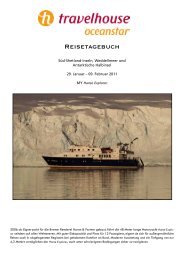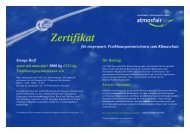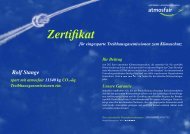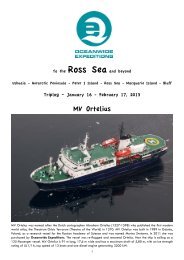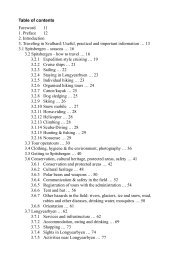ÐÐ ÐÎÎΡÐÐ ÐÐÐ¥ÐÐÐ - Spitzbergen
ÐÐ ÐÎÎΡÐÐ ÐÐÐ¥ÐÐÐ - Spitzbergen
ÐÐ ÐÎÎΡÐÐ ÐÐÐ¥ÐÐÐ - Spitzbergen
You also want an ePaper? Increase the reach of your titles
YUMPU automatically turns print PDFs into web optimized ePapers that Google loves.
In the afternoon, Jordi invited us for an introduction into the seabird world of the Southern Ocean.<br />
And indeed, we had already seen a veritable choice of these: the great Wandering Albatross was<br />
around our ship for most of the day, constantly accompanied by several smaller Black-browed<br />
Albatrosses and the odd Grey-headed Albatross, to mention the most important ones. Giant Petrels<br />
were seen several times, and smaller birds included Prions with their elegant, swallow-like flight.<br />
Even a first whale was seen in the afternoon, although it could not be identified.<br />
Later, "Jonas the incredible Swede" followed with an appetizer for diving at the cold ends of the<br />
world. In the evening, we rounded the day off in the Mikheev-cinema with the first part of Life in the<br />
Freezer. Our appetite for Antarctica grew with every mile that we sailed southwards!<br />
The Drake Passage<br />
The Drake Passage geologically opened about 22 to 30 million years ago, and connects the Atlantic<br />
with the Pacific Ocean, south of Tierra del Fuego. The South Shetland Islands lie south of this strait,<br />
which is here about 800-900 km wide. The Drake played an important part in the trade of the 19 th and<br />
early 20 th centuries before the opening of the Panama Canal in 1914. The stormy seas and icy<br />
conditions made the rounding of Cape Horn through the Drake Passage a rigorous test for ships and<br />
crews alike, especially for the sailing vessels of the day. Though bearing the name of the famous 16 th -<br />
century English seaman and explorer, the Drake Passage was, in fact, first traversed in 1616 by a<br />
Flemish expedition led by Willem Schouten. Sir Francis Drake sailed through the Straits of Magellan<br />
to the north of Tierra del Fuego, although he was subsequently blown south into the more extreme<br />
latitudes west of the passage by a Pacific storm. The passage has an average depth of 3400 m (11,000<br />
feet), with deeper regions of up to 4800 m (15,600 feet) near the northern and southern boundaries.<br />
The winds through the Drake Passage are predominantly from the west and are most intense in the<br />
northern half. The mean annual air temperature ranges from 5°C in the north to –3°C in the south.<br />
Cyclones (atmospheric low-pressure systems with winds that blow clockwise in the Southern<br />
Hemisphere) formed in the Pacific Ocean traverse the passage towards the southern end. Surface<br />
water temperature varies from near 6°C in the north to -1°C in the south, with the temperature altering<br />
sharply in a zone near 60°S. This transitional zone is known as the Antarctic Convergence, or Polar<br />
Front. It separates the sub-Antarctic surface water from the colder and fresher Antarctic surface<br />
water. At depths of between approximately 500 to 3000 m there occurs a layer of relatively warm and<br />
salty deep water. The maximum extent of sea ice occurs in September, when between 25% and 100%<br />
ice cover extends as far as 60°S. Ice floes occasionally reach Cape Horn.<br />
The water within the passage flows from the Pacific into the Atlantic, except for a small amount of<br />
water in the south that comes from the Scotia Sea. The general movement, know as the Antarctic<br />
Circumpolar Current, is the most voluminous in the world, with an estimated rate of flow between<br />
950 to 1500 Mio cubic metres per second.<br />
23 rd March 2008 – Southbound in Drake Passage<br />
Position at 08.00h: 59°25’ S / 62°04’ W<br />
215 nm to the South Shetland Islands<br />
Air temperature: 0°C, overcast, decreasing wind force 4 and swell, cloud cover<br />
Most of us would remember this night as a moving experience, as the swell had reached<br />
considerable size due to winds winds that reached more than 20 m/s during the early hours.<br />
Bed was certainly not a bed place to be under these conditions, and anybody who might<br />
have seen us from outside would probably have suspected us of major take of stimulating liquids – but<br />
really, the liquid that made us move was everywhere outside the ship, rather than inside.<br />
We had crossed the Antarctic convergence during the night, the invisible boundary zone that separates<br />
more temperate waters in the north from the cold Antarctic water body that surrounds the last<br />
continent. In other words: we had entered Antarctica, ecologically speaking. The political dimension<br />
followed soon, as we crossed 60°S during the day, thus entering the area that is governed by the<br />
Antarctic Treaty.<br />
Chess was played, books were read, birds were observed and lectures were attended during the day, as<br />
conditions calmed gradually down. Rolf called us together for a mandatory introduction to rules of<br />
Good Behaviour in Penguin Country ("IAATO-briefing") – after all, these polite creatures would meet<br />
us in in tailcoat, so we simply had to live up to Antarctic standards of etiquette. This, by the way, also<br />
4




